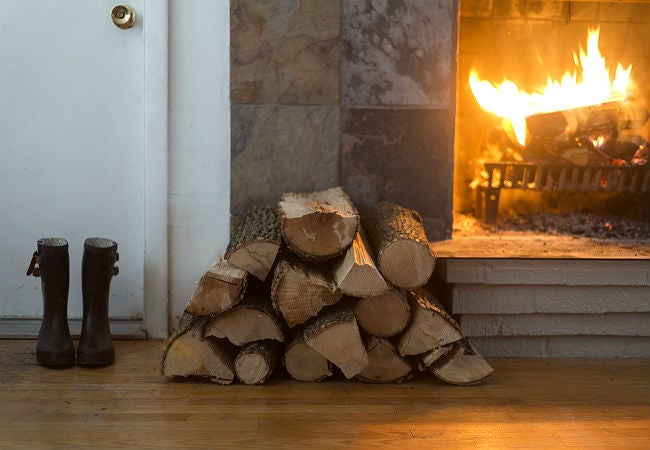The act of burning wood in a fireplace is an age-old tradition, providing not just warmth but an ambiance that’s unparalleled. With the crackling of logs, the aromatic scent of burning wood, and the mesmerizing dance of flames, a fireplace is often the heart of a home. In this detailed guide, we’ll explore the intricacies of burning wood in a fireplace, ensuring safety, efficiency, and that ever-soothing experience.
Burning Wood in a Fireplace: Setting the Stage
Burning wood in a fireplace is not just about tossing logs into the hearth. It’s an art and a science, combined. Proper preparation, the right wood, and understanding airflow can create the difference between a smoky room and a delightful fire.
Selecting the Right Wood
Hardwoods vs. Softwoods
Not all woods are created equal. Hardwoods, derived from trees like oak and maple, burn slower and produce more heat. Softwoods, on the other hand, come from trees like pine and spruce, and while they catch fire quickly, they burn out faster.
Seasoned vs. Fresh Wood
Using seasoned wood, which is wood that’s been dried for at least six months, is crucial. It produces less creosote, ensuring a cleaner burn and less buildup in your chimney.
Local Woods: Embracing the Environment
Opting for locally-sourced woods can have multiple benefits. It supports local businesses, reduces transportation emissions, and ensures that you’re using wood suitable for your region.
Safety First: Preventing Accidents
Regular Chimney Cleaning
This is paramount. A clean chimney ensures optimal airflow, reduces creosote buildup (a leading cause of chimney fires), and enhances the efficiency of your fireplace.
Setting Up a Fire-Resistant Perimeter
Always have a non-flammable perimeter around your fireplace. It safeguards your home from stray sparks that might jump out.
Using a Fireplace Screen
A screen isn’t just decorative; it’s a safety essential. It keeps those popping embers in place and deters children and pets from getting too close.
Enhancing Fireplace Efficiency
Using a Fireplace Insert
An insert can convert a traditional fireplace into a more efficient heat source, reducing drafts and increasing heat output.
The Art of Stacking Firewood
Believe it or not, how you stack your firewood can greatly affect your burning efficiency. The “upside-down” method, where larger logs are at the bottom and kindling on top, is a fan favorite.
Ensuring Proper Airflow
Your fireplace requires oxygen to burn efficiently. Making sure there’s adequate airflow can reduce smoke and ensure a more consistent burn.
The Environmental Impact of Burning Wood
Carbon Neutral?
Burning wood releases carbon dioxide. However, the carbon released is equivalent to the amount absorbed by the tree during its lifetime, making it almost carbon neutral.
Using Efficient Burning Practices
By optimizing your burn (using seasoned wood, ensuring proper airflow), you can reduce the number of particulates released into the air.
Supporting Reforestation
If you’re an avid fireplace user, consider supporting reforestation efforts. Planting trees can offset the carbon footprint of your cozy fires.
Benefits of Burning Wood in a Fireplace
A Natural Humidifier
The process adds moisture to the air, acting as a natural humidifier, which can be particularly beneficial during drier months.
Energy Independence
Relying on your fireplace for heat can reduce dependence on external energy sources, often leading to cost savings.
The Therapeutic Effect
There’s something undeniably therapeutic about watching flames dance. It offers a chance to unwind, relax, and even meditate.
Conclusion
Burning wood in a fireplace transcends mere functionality. It’s an experience, a ritual, and for many, a way of life. By following best practices, ensuring safety, and understanding the nuances, one can transform this simple act into a soulful journey, embracing warmth in every sense of the word.
FAQs
What types of wood are best for burning in a fireplace?
Oak, hickory, and maple are among the best hardwoods for burning, offering a longer, cleaner burn.
How often should I clean my chimney?
At a minimum, once a year, usually before the burning season starts.
Can I burn treated wood in my fireplace?
No, burning treated wood can release harmful chemicals into your home and is not recommended.
Is burning wood eco-friendly?
When done responsibly and efficiently, it can be considered more eco-friendly than some other heating options. However, it’s essential to use seasoned wood and ensure efficient burning practices.
Why is my fireplace smoky?
This could be due to various reasons such as using wet wood, poor airflow, or a dirty chimney.
How can I make my fireplace more efficient?
Using seasoned wood, ensuring proper airflow, regular cleaning, and possibly using a fireplace insert can boost efficiency.


